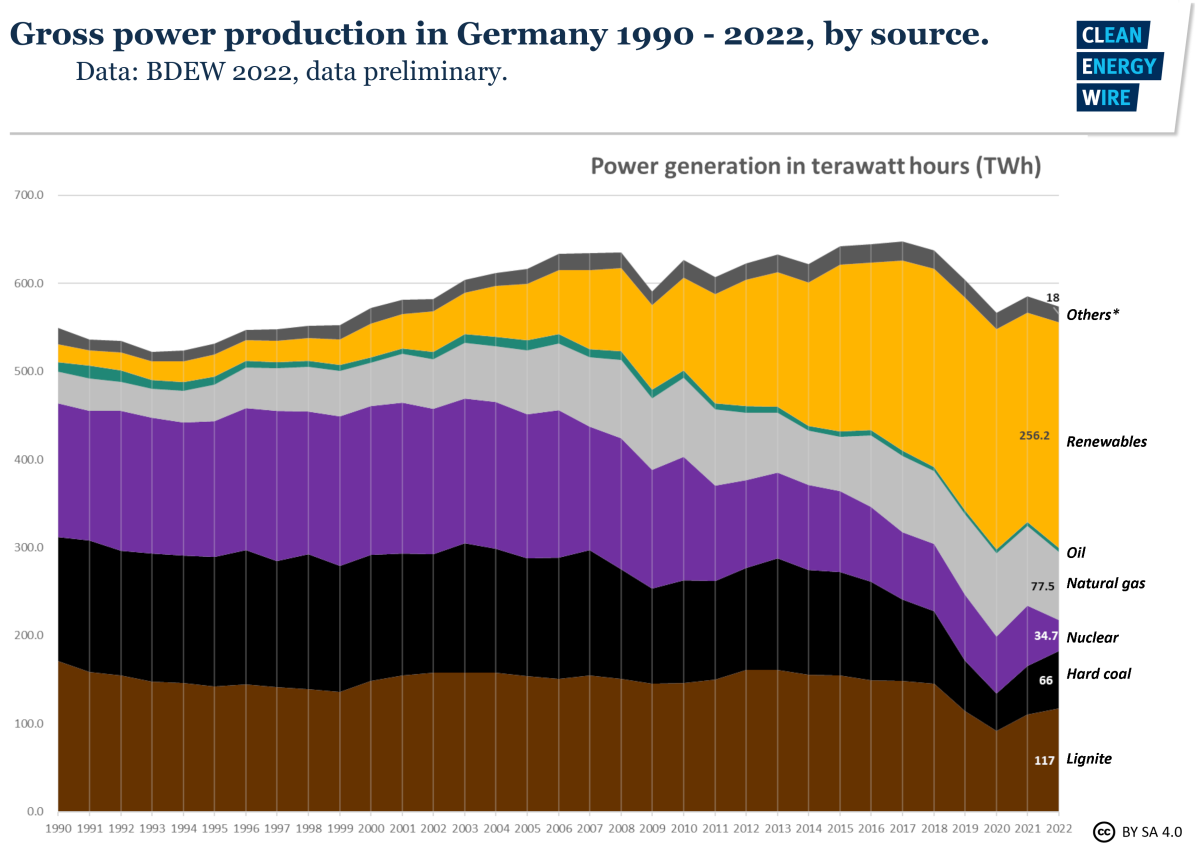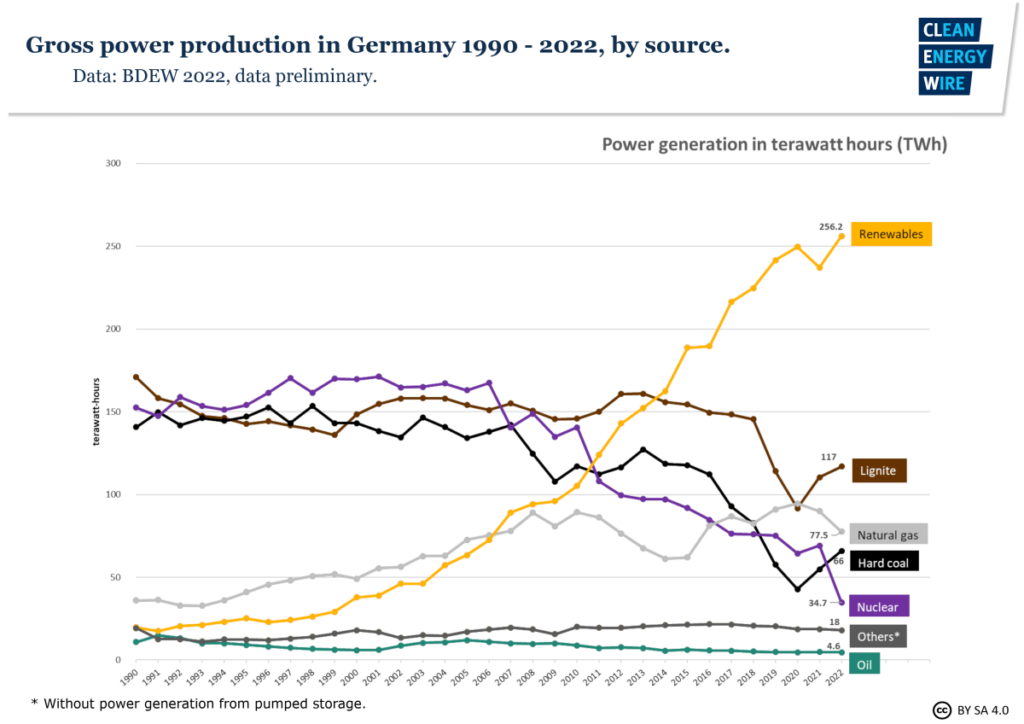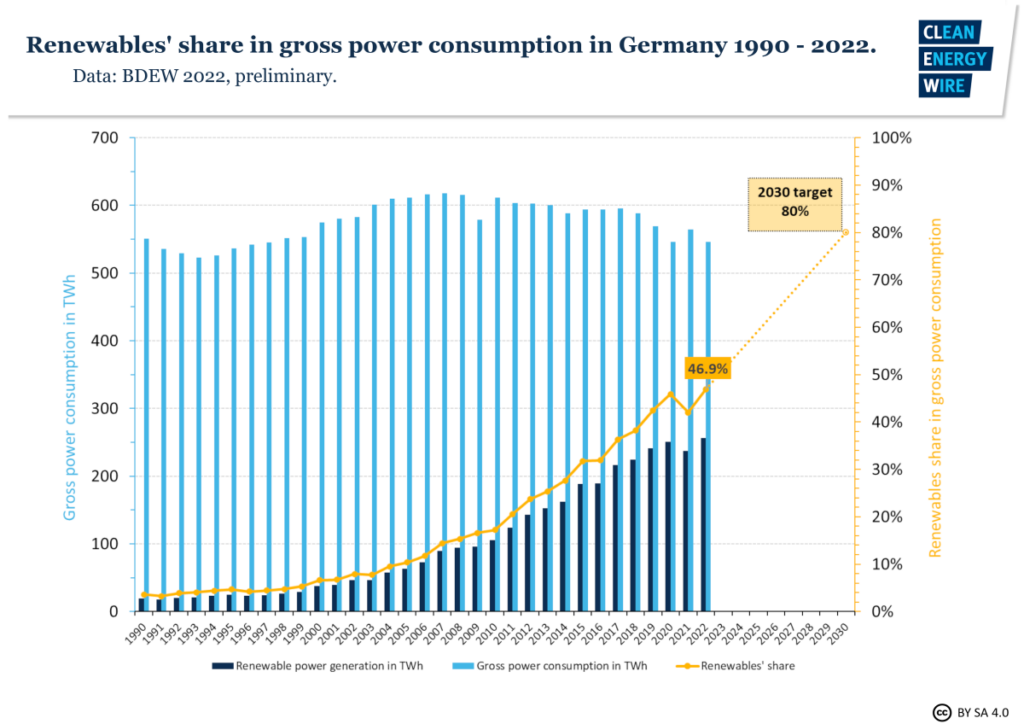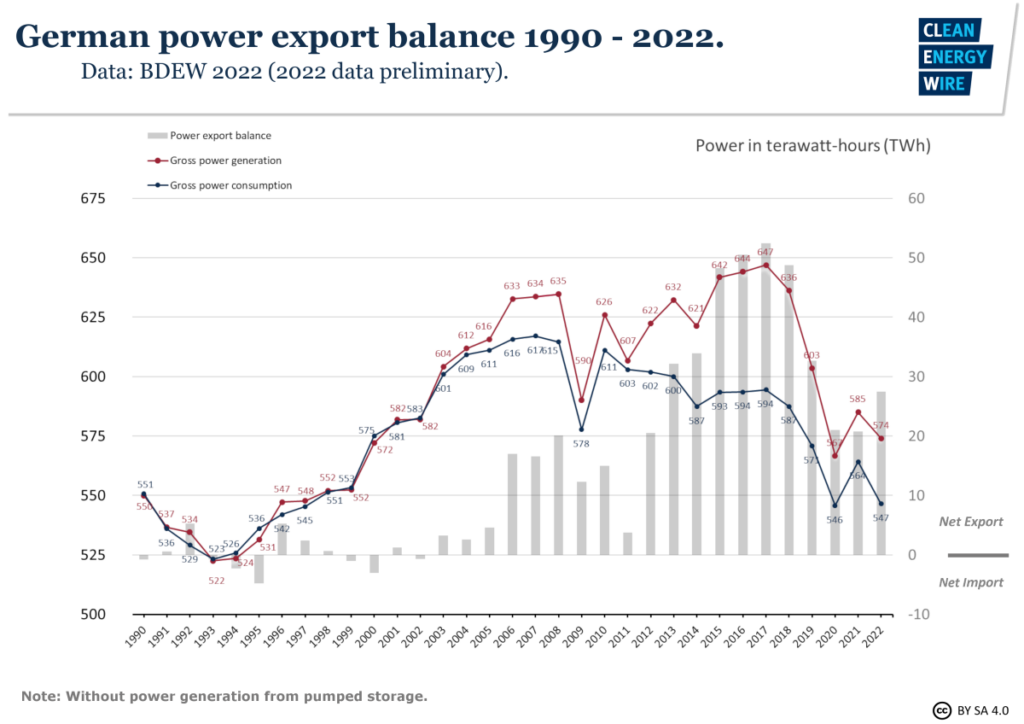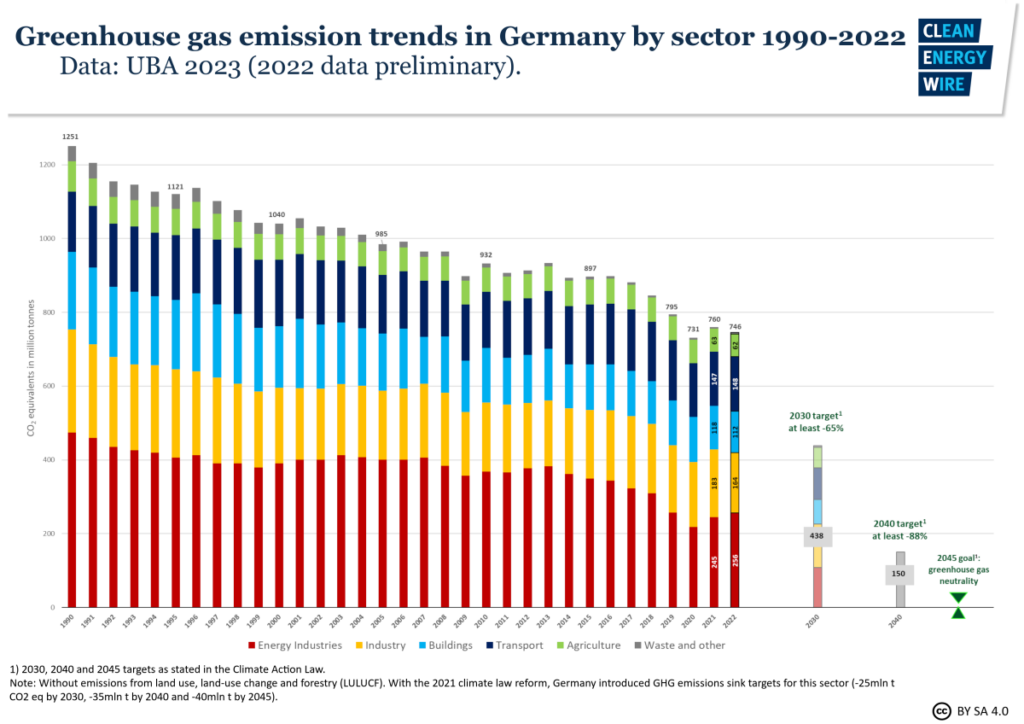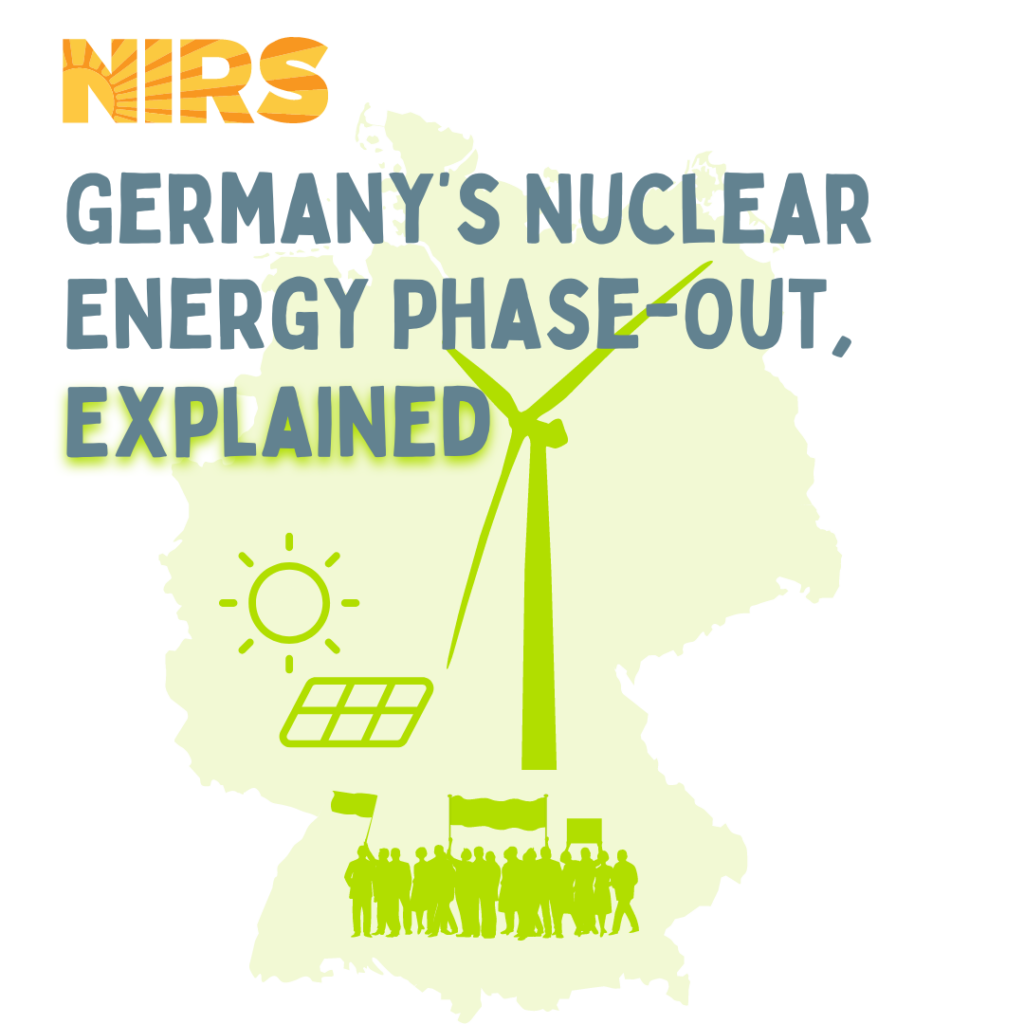
On April 15, 2023 utilities in Germany shut down the country’s three last remaining nuclear power plants. These closures mark the successful planned phase-out of German nuclear energy from the nation’s grid.
What does this mean for Germany? What lessons should the U.S. take away from the German energy transition?
Germany’s Energiewende (“energy transition”) is an overarching policy commitment to achieve a low-carbon, nuclear-free economy and transition to renewable energy. While the recently completed phase-out of nuclear power is a major milestone for Germany’s energy transition, it was by no means a perfect process nor is the current energy system in Germany a perfect example to follow.
But, Germany’s transition shows that an energy policy grounded in environmental values works – and the earlier climate policy is implemented, the sooner the climate policy goals can be realized. Above all, the German energy transition shows the tremendous power of active citizenry, organized social movements, and activism to transform policy and successfully demand change.
The Success Story of Germany’s Anti-Nuclear Movement
One of the key drivers of the German government’s ultimate decision to phase out the nation’s nuclear reactor fleet was the strong anti-nuclear movement in Germany. This movement raised concerns about the safety of nuclear power and the risks posed by nuclear waste. It was German activists who laid the groundwork and secured Germany’s total phase-out of nuclear energy, not the government or utilities.

The anti-nuclear movement in Germany has a rich and complex history dating back to the Cold War era. The movement gained momentum in the late 1970s and early 1980s, and continued to grow due to widespread concerns about the potential dangers of nuclear power, the legacy and impact of the horrors of the Chernobyl disaster in 1986, and the ongoing threat of nuclear weapons. The anti-nuclear movement and other environmental activists formed the Green Party in the late 1970s and became a strong political force in Germany (and arguably the strongest Green Party in the world.)
The Gorleben nuclear waste repository, a disused salt mine located in Lower Saxony on the then-border of East Germany where the German government transported and stored high-level nuclear power waste, became a focal point of the movement. German activists mobilized against the proposed waste site due to concerns about its suitability as a storage site and the government’s lack of transparency and consultation with local communities. The first protests against the Gorleben repository began in the 1970s, and civil disobedience actions intensified throughout the 1980s and 1990s. Activists established a permanent protest camp near the site, and organized protests, blockades, and other direct actions to disrupt the transport of nuclear waste to the repository. In 1997, police and protestors clashed as activists tried to prevent a train carrying nuclear waste from reaching the site. Actions took place at Lueneburg and Gorleben, March 1-4, 1997, as the German government transported six CASTOR casks of high-level nuclear waste from southern Germany to the small farming town of Gorleben in northern Germany. The transport brought at least 20,000 protestors, 30,000 police, and cost $100 million. Protests against waste shipments headed for Gorleben sparked massive resistance, civil disobedience, and action throughout the 2000s.
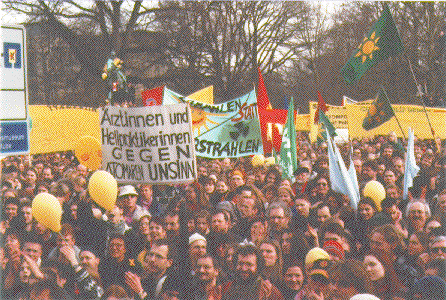
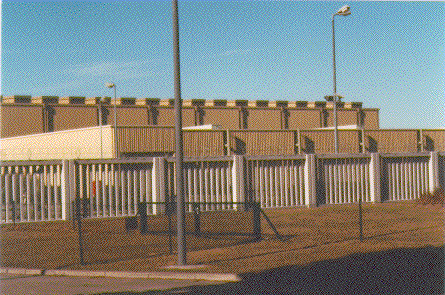

Police shoot water cannons at four protestors tied to the trees above the Castor transport road.
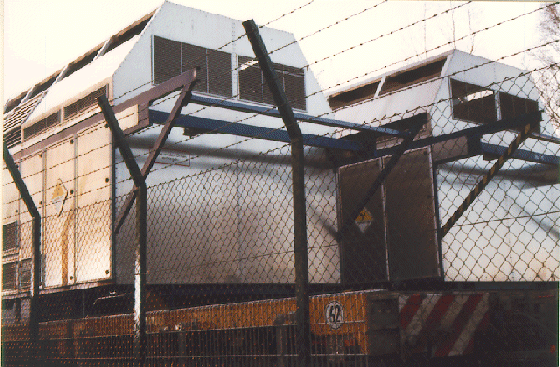
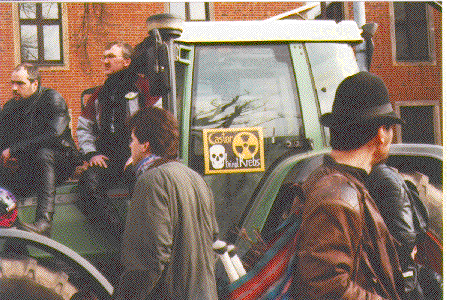
Farmers at the March 1 rally in Lueneburg. The sign in the tractor cab says, “Castor causes cancer.”
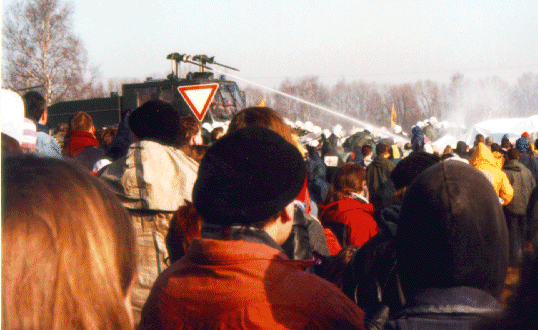
Police shoot water cannons at protestors blocking the Castor transport route. According to various reports, there were 500 arrests and, late reports indicate, as many as 500 injuries.
While shipments of nuclear waste casks were sent to Gorleben for decades, the waste was never actually loaded into the proposed repository. Construction of this repository was halted and the CASTOR casks were housed in a large building near the site, where they were intended to be held temporarily until they were placed in the salt mine. Despite the protests and opposition, the Gorleben “interim” storage facility repository continued to receive nuclear waste until it was officially closed in 2022 as part of Germany’s phase-out of nuclear power. The casks remain at Gorleben to this day. The rest of the nuclear waste in Germany is stored at interim storage facilities located at nuclear power plant sites or at centralized “interim” storage facilities such as the one in Gorleben.
The anti-nuclear movement in Germany endures, with many activists continuing to push for greater accountability and transparency around nuclear waste management, and for a transition to renewable energy sources. The Gorleben protests remain a powerful symbol of grassroots resistance and civil disobedience, and serve as a reminder of the ongoing struggle to create a more sustainable and just energy system.
The continued ripples of change from the decades of anti-nuclear activism in Germany are a big part of why Germany adopted the policy to phase out nuclear power. The German Green Party made the phase-out of nuclear power a key part of its platform and the Social Democratic Party (SPD), which has also been historically aligned with the Greens on environmental issues, also supported the phase-out. In 2002, this “red-green” government passed a law banning new nuclear power plants from being built and initiated the 20-year phase-out of the German nuclear fleet.
However, when Angela Merkel’s Christian Democratic Party took power in 2005, their support for nuclear power threatened the phase-out and the party effectively scrapped the program in 2009. Then came Fukushima. The Fukushima disaster in 2011 was a major turning point for Germany’s nuclear phase-out. Within days of the Fukushima earthquake, tsunami, and meltdowns, Merkel’s government reversed its previous position and re-committed Germany to phasing out nuclear power by 2022. The decision was supported by a large majority of the German public, and since then, the country has undergone a rapid transition to renewable energy sources such as wind and solar power.
A Look at Germany’s Energiewende (Energy Transition)
Today, Germany is a global leader in renewable energy, and its phase-out of nuclear power can be seen as a model for other countries seeking to transition away from both nuclear power and fossil fuels and establish a carbon-free, nuclear-free energy system. Over the last decade, Germany has conducted a thorough phase-out of nuclear power, coupled with a massive build-out of renewable energy.
Let’s take a look at the facts of Germany’s energy transition since it began ramping down its nuclear power capacity and investing in alternative, renewable energy.
Fact #1 : As Germany has phased out nuclear power, it has massively built renewable energy generation, which now provides a majority of energy in Germany.
These graphs illustrate Germany’s transition from nuclear energy to renewable energy sources. From less than 10% in 2009, the share of renewables in Germany’s energy mix has increased significantly to 46.9% in 2022. Meanwhile, the use of coal, lignite, and fossil fuels has not filled the gap. Rather, the expansion of renewables has made up the difference and Germany’s dependence on fossil fuels has in fact declined since 1990. Therefore, the argument that Germany’s nuclear phase-out has led to an increased reliance on fossil fuels is unfounded. The phase-out of nuclear energy, coupled with the expansion of renewables, has helped clean up the country’s energy grid by reducing both radioactive waste production and emissions. This demonstrates that a nuclear power phase-out, when combined with the right investments and policy strategies that prioritize renewable energy development, can effectively support decarbonization efforts and contribute to reducing emissions.
Fact #2: Germany is a net exporter of a significant amount of electricity it generates, in addition to having significantly reduced net exports since 2017. Decreases in net exports coincided with significant reductions from all sources of fossil fuel generation (as well as nuclear) and a more than 25% increase in renewables, shown above.
German energy exports matter because a significant part of Germany’s electricity generation is driven by demand from neighboring countries. At some times, Germany is feeding renewable energy to other countries, displacing fossil fuel generation there. At other times, fossil fuel power plants in Germany operate to meet power demand in other countries. Nevertheless, Germany has dramatically reduced its net exports in recent years, as it has been phasing out nuclear power plants and reducing fossil fuel generation.
Three recent factors have placed additional demand on Germany for power exports:
- France’s precipitous decline in nuclear generation, for which France has not been at all prepared, has placed additional demand on German energy exports. France’s nuclear output at the end of 2022 hit a 30-year low, forcing France to import electricity and prepare plans for possible blackouts as a cold snap fuels demand for heating. The country’s energy policy has remained centered on nuclear power, despite mounting shortfalls in generation, and it has not been expanding renewable energy and efficiency to help make up the gap, as Germany has.
- The pandemic led to sharper declines in electricity demand in 2020, which surged back up in 2021 as economic activity spiked.
- Russia’s war on Ukraine and the destruction of the Nordstream 1 & 2 gas pipelines significantly reduced the supply (and reliability of supply) of gas for electricity, heat, and industry. That also caused the cost of gas to spike. Scarcity and high cost led to near-term increases in demand for coal. But total fossil fuel consumption generation in Germany declined in 2022, back down below even 2020 levels from the increase in 2021.
If all of these factors are taken into account, fossil fuel generation in Germany is still on the decline. Plus, the German government even pushed up the timeline for phasing out coal to 2030 last fall, in the face of all of these factors.
Fact #3: Germany’s emissions have continued to go down throughout the energy transition, reaching 40% below 1990 levels in 2022. That has been led by reductions in the electricity sector (“Energy Industries”) and Buildings (heating, cooking, etc.)
We can see the emissions impacts of Germany’s nuclear-phase out and renewable build-out in the data. Moreover, Germany’s power sector emissions are on track to meet the goal. It is in transportation and industry where Germany is really falling short. These are significant reductions in emissions. And, this is just a snapshot of the larger transition underway in Germany to consider as we take stock of the impacts and successes of the nuclear energy phase-out so far. The bottom line is that Germany’s nuclear-phase out has coincided with a period of radically reduced carbon emissions in the electricity sector.
It is a success story. Germany’s energy transition has, so far, resulted in a massive build-out of renewable energy and significant reductions in emissions. There is still work to be done in managing the legacy of nuclear power waste from German reactors and continuing the transition to a fully sustainable energy system, including phasing out fossil fuels and wood-burning biomass. Continued efforts and investments will be necessary to accelerate the energy transition and achieve Germany’s ambitious climate targets.

